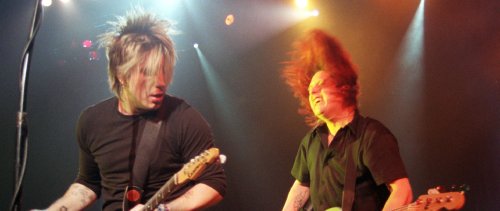Goo Goo Dolls' 'Dizzy Up the Girl' turns 20: From the Continental to the arena stage
Other • October 12, 2018 • The Buffalo News
The late '90s were a strange time for rock music.
Grunge had morphed into mostly horrible rap-metal. The mainstream was littered with over-singing divas like Celine Dion. Hip-hop was healthy, thanks to the likes of the Wu Tang Clan, though it was still reeling from the death of Tupac. Brit-pop was big, and some of it was pretty great, though much of it was far from inventive or groundbreaking.
What they were then calling "electronica," and we now uniformly label EDM, was supposed to be driving the final nail into guitar-based rock music’s velvet-lined coffin. Country-pop was huge. R&B was awaiting a renaissance that would soon come.
The most interesting rock music was becoming almost avant garde in its ability to willfully twist tradition into new forms, a la Radiohead, Mercury Rev and the Flaming Lips, among others.
What was a scruffy bar band from Buffalo with a Replacements fetish and only middling success on its resume to do? For the Goo Goo Dolls’ John Rzeznik, the answer was to finally slow down and focus enough on his craft to become the songwriter he longed to be. So one day, he dropped his acoustic guitar into a friendly open tuning – DAEAAE, from lowest string to highest – and out came the skeleton of “Name,” which would become the band’s breakthrough hit while simultaneously convincing Rzeznik that, despite his sometimes crippling misgivings and nagging self-doubt, he might be a songwriter of some stature after all.
“Name” was released in 1995 on the band’s “A Boy Named Goo” album, where it nestled up against songs that generally fit the band’s prior incarnation as an alternative rock band with punk-pop roots.
“Name” was a huge hit, and so one is comfortable assuming its creator felt a not inconsiderable amount of pressure to follow it up when it came time to hit the studio for the sessions that would ultimately yield “Dizzy Up the Girl,” the Goos’ sixth album overall, and their first made in the shadow of a huge mainstream hit.
Rzeznik delivered. Big time. And in the process, he set the band on the course it continues to follow to this day.
Most of those Replacements influences were gone. The roughshod act so many of us would gather to raise our beers to in the darkness of the old Continental was transformed into an uber-tight, sometimes slick unit that made friendly, eminently tuneful, mildly alternative rock music for people who quite likely had no idea who Paul Westerberg was. The Goo Goo Dolls became an arena-sized pop-rock band.
“Name” was a watershed, of course, and once it had broken, Rzeznik rode the current, in the process coming up with a batch of songs that would define not only his career, but the sound of mainstream alternative rock – for it was indeed both – for the next decade.
“Iris” was the one, the baby sister of “Name,” and a song that married an unsettling sense of yearning to an indelible hook, a melody of the sort that songwriters wait their whole lives for. It became a runaway hit. Happily, Rzeznik had loaded the album with songs boasting similar pop smarts and hook-infused muscle. “Broadway,” “Black Balloon,” “Slide,” “Dizzy” – all of these songs charted. The Goos were officially the biggest rock band to have emerged from Buffalo.
As the band comes to Shea’s Performing Arts Center for three sold-out shows Oct. 19 to 21, celebrating “Dizzy’s” 20th birthday, the album remains the group’s crowning achievement – a record that bridged the gap between alternative rock and the mainstream without sacrificing all of its integrity on the altar of pop success.
The taut, economical, emotional and undeniably tuneful nature of the album – as well as its trademark blend of acoustic and electric guitars, its pop-friendly veneer, and its earnest intelligence – could be heard echoed in the work of bands like Semisonic, Collective Soul, Live, Matchbox Twenty and the Wallflowers, all of whom would enjoy hits in the “Dizzy” mode.
The Goos made it under the wire in what we now know were the twilight hours of the major label music industry. It’s highly unlikely we will ever see a rock band from Buffalo selling more than 4 million copies of a single album again. Twenty years on, “Dizzy” remains a fitting testament to a tumultuous time in rock music. It built a bridge from the fringes to the mainstream. And once it had crossed that bridge, it burned it down.
A look back: September 1998
Here is what else was going on in the world and Western New York in September 1998:
- Google, founded by Stanford Ph.D students Sergey Brin and Larry Page, is incorporated.
- “Rush Hour,” starring Jackie Chan and Chris Tucker, is a box office smash.
- Gas prices in Western New York are hovering around $1.03 per gallon.
- The Bills go 0-3 to start the season, but Doug Flutie later takes over as the starting quarterback and leads the Bills to a 10-6 regular season and playoff berth.
- Expectations are high for the Sabres, beginning their third season in then-Marine Midland Arena, after an Eastern Conference Finals run the previous season. The Sabres go 37-28-17 and make a run to the Stanley Cup Finals in 1999, losing on the infamous Brett Hull skate-in-the-crease goal.